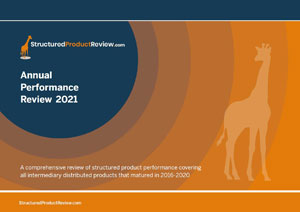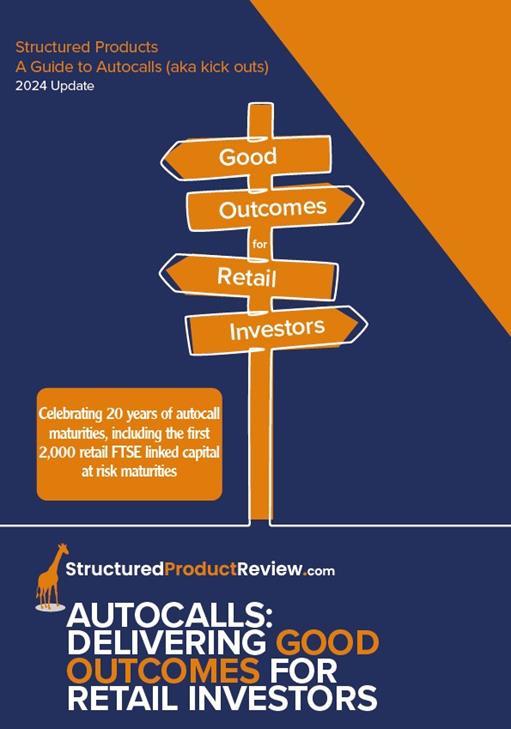20/09/2023
By the late 1990’s a number of structured product providers were participating in the UK sector, all mainly focusing on growth products. Towards the turn of the century falling interest rates led to the introduction of income-based solutions with regular, non-conditional income payments throughout the term and the ultimate return of capital dependent upon the underlying index being at least equal to the strike level, or not breaching the capital protection level throughout the investment’s life. Developed market indices were at all-time highs and high investor risk appetite, or risk ignorance meant these new breed of income products proved very popular. However as the nineties turned to the noughties and incumbent and new product providers fought for market share, headline income rates grew via increasingly convoluted structures which ultimately increased risk to capital. For example, downside risk could be leveraged or geared meaning that for every 1% fall in the underlying index at the end of the term there could be a more than 1% reduction to capital. Combine this with the dot-com bubble bursting and many of these products were destined to fail.
One example of this unpleasant breed was the Canada Life High Income Bond Series 3: offering headline rates of 10.5% income each year for three years. Beyond utilsing a misleading approach where the investment term was three months longer than the income term this was a true precipice bond with geared potential downside. The return of invested capital was subject to the Nasdaq100 not declining more than 20% at the end of term but if it had, capital would be lost at a rate of 3.33% for every additional 1% the index was down. Whilst income was paid throughout the term, over the period the Nasdaq fell by more than 70%. With the index being more than 33.3% below the 20% capital protection barrier the leveraged loss mechanism meant that none of the original capital was returned.
Beyond the use of geared downsides, volatile indices and extended investment terms without compensatory returns other tactics were used by certain providers to enhance quoted headline rates. Linking capital return to multiple indices with the worst performing dictating the outcome, or to baskets of individual shares became commonplace. Of course, dual index and share linked structures still exist today, however we now see far less complexity surrounding the capital protection terms. Today the norm is for a single end of term barrier observation date but back in early 2000’s some products referenced the lowest, intraday point of the underlying observed during periods as long as the final three months.
Several parties, including ourselves attempted to raise awareness and warn against these unfavorably structured, high income paying products but they still attracted a substantial number of investors, many of whom suffered significant losses due to the stockmarket fall that ensued over their investment periods.
Such investments were subsequently dubbed ‘precipice bonds’ by the Financial Services Authority who found multiple instances where the providers had failed to give due prominence to the risks as well as utilising questionable sale techniques. In the highest profile case Lloyds TSB agreed to pay £98 million compensation to 23,000 investors and were fined £1.9 million for mis-selling a Scottish Widows share linked income plan. Notably, the FSA did not critise Lloyds or Scottish Widows for the structure of the product, but by the way it was sold.
If different market conditions had resulted and the dot-com crash wasn’t as severe, it might be a case of a different story to tell, however as history demonstrates time and time again, corrections happen. Even without such a correction, the terms of many precipice bonds and the sales and promotion techniques used in many instances would fail any clear, fair and not misleading test.
Precipice bonds with geared downsides existed for a brief period and they, together with the questionable and misleading structuring strategies used were promptly banished from the UK sector in 2004 never to return. During the time when precipice bonds emerged, it is important to note that markets and its participants were in a state of euphoria, it was common to see newly created companies with little to no revenue reach huge stock market valuations for the bubble to burst in a matter of months.
As to the defence of precipice bonds per-se, there really isn’t one. Many of these contracts were poorly constructed, sold in questionable ways and as it transpired, offered at the worst possible time.
As for the defence of structured products per-se; The precipice bond issue was more than twenty years ago, not all structured products were precipice bonds, not all providers issued such and ultimately, decisive regulator and sector action saw the matter contained to the extent that sector improved as a result.
All sectors evolve and improve with the catalysts for change often being unpleasant. The Neil Woodford debacle four years ago and the Arch Cru failure 15 years ago are obviously not reasons for investors and advisors to shun all collective investments. Likewise, the precipice bond issues of twenty years ago provide no justification for advisers to shun all structured products. Increased oversight, safeguarding and regulatory procedures have arisen following such matters and the result is better investor protection.
If you have any comments, insights or feedback, please don't hesitate to share with us by emailing enquiry@StructuredProductReview.com
Structured investments put capital at risk.
Also in this section
- How old is too old? Are structured products to die for?
- Product focus - October 2024
- Q3 2024 Issuance
- Q3 2024 maturity results
- A share of spread bets on steroids?
- Product focus - September 2024
- Maturities of the month - August 2024
- Right on time
- Product focus - August 2024
- Keep calm and zoom out
- 2,000 and counting
- Q2 2024 maturity results
- 20 years of autocall maturities
- Product focus - June 2024
- Fixed income or interest?
- Maturities of the month - May 2024
- The barrier debate - revisited
- Product focus - April 2024
- Maturities of the month - April 2024
- Time to call
- I don't believe markets are ever too high for Structured products!
- Notes on counterparty exposure
- Return of Nikkei
- Q1 2024 issuance
- Q1 2024 maturity results
- Structured Products – AAAAAGH!
- Hop in CIBC
- Re-enter Santander
- How to build a financial fortune - revisited
- Issuance in 2023
- Where's the risk?
- Questionable offerings
- Challenging the case against structured products - 'Loss of dividends'
- Navigating the investment landscape
- Challenging the case against structured products - Counterparty risk
- 6-year autocalls approaching final destination
- 1,750 FTSE capital at risk autocall maturities
- The leopard that changed her spots
- Q3 2023
- Challenging the case against structured products - Keydata
- Dilemmas for UK IFA's and the unique role of Structured Products
- 'High charges'
- Precipice bonds
- Intro
- FTSE 100 Contingent Income
- Indexing the indices
- Something different
- Investing through volatility
- 100 10:10s
- The best or worst?
- The 10%/25% 'Rule' that never was
- Structured products and the yield curve
- Fixed income: Capital at risk?
- Prospects for UK inflation - and fun with A.I!
- The Barrier Debate
- More Deposits for now
- Last of the Americans
- What if?
- Time heals all wounds, we hope...
- How to diversify portfolios using structured products?
- The Proof Is In The Pudding...
- Debunking Structured Misconceptions
- 1,500 FTSE Capital-at-Risk Autocall Maturities
- Q3 2022 Maturity Results
- What do we prefer?
- Deposits vs Capital ‘Protected’
- There’s time yet…
- Where did you invest your clients?
- A Six-Month Reflection
- Return of the Rev Con
- Happy 2nd Birthday FTSE CSDI
- Q2 2022 Maturity Results
- The best and worst yet still the best
- Critique my Suitability - Mariana 10:10 Plan June 2022 (Option 2)
- 10/10 for 55 10:10’s
- Q1 2022 Maturity Results
- 'How to build a financial fortune': a follow up
- Critique my Suitability - Mariana 10:10 Plan April 2022 (Option 2)
- 2021 Capital-at-Risk Autocall Maturity Review
- An unwelcome return...
- CSDI's First Birthday
- Bon Anniversaire
- Introducing the FTSE Custom 100 Synthetic 3.5% Fixed Dividend Index
- Q3 2021 Maturity Results
- Critique my Suitability - Mariana 10:10 Plan October 2021 (Option 2)
- Blurring the lines...
- Beware of false knowledge; it is more dangerous than ignorance
- Good news, bad news...
- Certainty is Certainly a Benefit
- Critique my Suitability - Mariana 10:10 Plan September 2021 (Option 2)
- A Twenty-Year Progression
- Q2 2021 Maturity Results
- Nine 8:8s Post Positive Returns in Falling Markets
- Critique my Suitability
- Q1 2021 Maturity Results
- Morgan Stanley’s Marvelous Maturity Medley
Current Products
We review the UK's retail structured investment sector, providing pertinent support for Professional Advisers and relevant research tools.
View all ⟶


